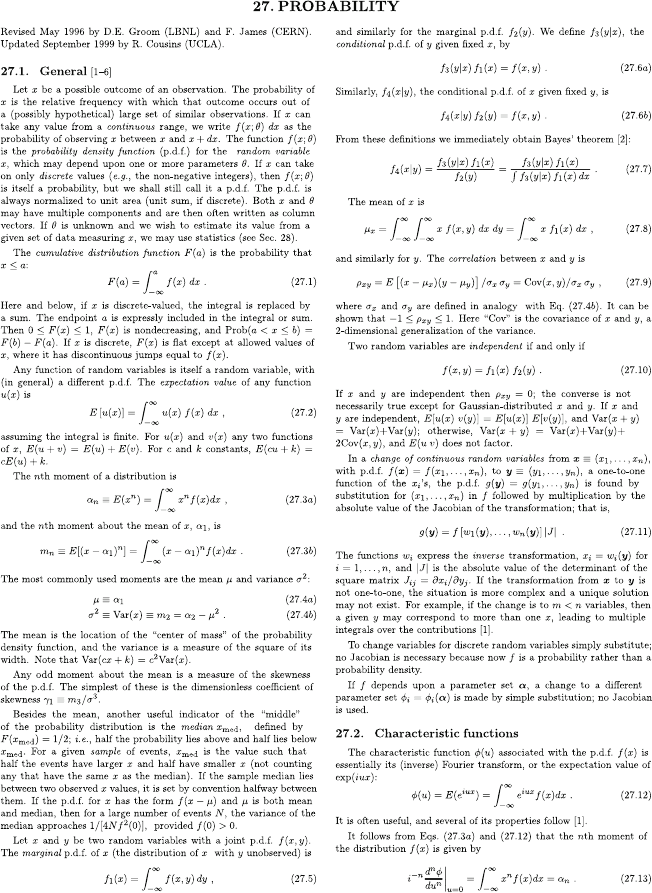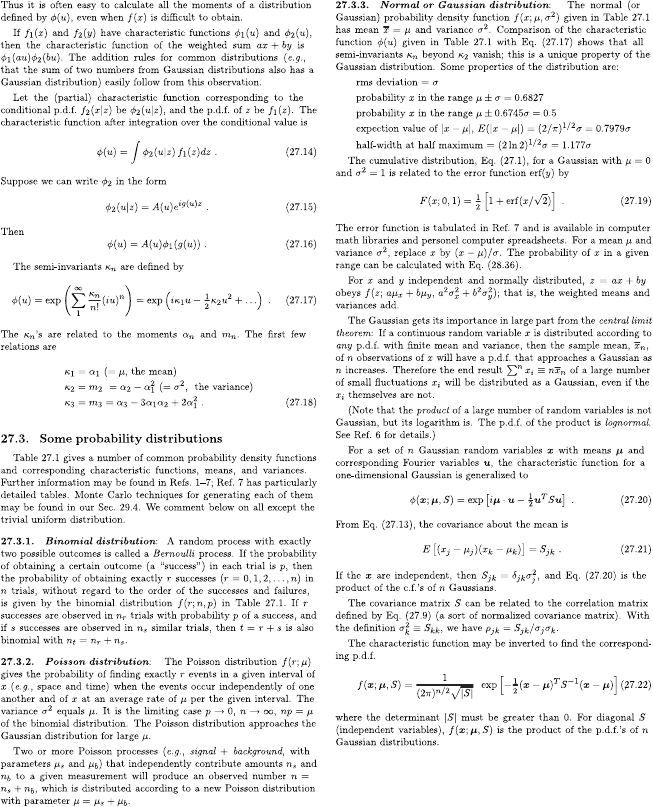Leroy C., Rancoita P.-G. Principles Of Radiation Interaction In Matter And Detection
Подождите немного. Документ загружается.


January 9, 2009 10:21 World Scientific Book - 9.75in x 6.5in ws-bo ok975x65˙n˙2nd˙Ed
810 Principles of Radiation Interaction in Matter and Detection
A.7 Free Electron Fermi Gas
A number of physical properties in metals can be understood in terms of the free
gas electron model, which was put forward by Drude in 1900 to explain the metallic
conductivity. According to this model, some (conduction) electrons are free to move
around the whole conductor volume. These electrons behave as molecules of a perfect
gas. Forces among conduction electrons and ions are neglected. This classical theory
accounts, among others, for the derivation of Ohm’s law and, furthermore, for the
relation between electrical and thermal conductivity. While it fails to explain other
phenomena like, for instance, the heat capacity and the paramagnetic susceptibility
of conduction electrons.
In free classical electron model, the electron kinetic energies can have any value
and, as the temperature decreases, the average kinetic energy decreases linearly
with the temperature becoming zero at 0 K (K is the absolute temperature in units
of kelvin). In fact at thermal equilibrium, the average kinetic electron energy is
3
2
kT
(k is the Boltzmann constant) and is derived assuming that electrons obey to the
classical Maxwell–Boltzmann statistics.
In quantum-mechanics not all the energy levels are permitted and the continuous
energy distribution is replaced by a discrete set of energies. In addition, electrons
have an intrinsic spin angular momentum of
1
2
~ and, at 0 K, they must occupy
energy levels consistent with the Pauli exclusion principle, i.e., their mean energy
is far from zero. The statistics taking into account the Pauli exclusion principle is
the Fermi–Dirac statistics. A gas is called degenerate when deviations from classical
properties occur. In 1927, Pauli and Sommerfield pointed out that the electron gas
within a metal must be treated as a degenerate gas, whose properties are essentially
different from those of an ordinary gas. It turns out that, at ordinary temperatures,
the energy distribution differs very little from the one at 0 K.
Following the treatment in Section 4.2 of [Bleaney, B.I. and Bleaney, B. (1965)],
let us consider the momentum space, where the coordinates are the components
(p
x
, p
y
, p
z
) of the momentum instead of the components of the position (x, y, z). In
this space the particle momentum is represented by a point. The magnitude and
direction of the momentum are the length and the direction of the radius vector from
the origin of the coordinate system and to the momentum point. From Heisenberg’s
uncertainty relation (see page 232) we have that momentum components cannot be
determined more precisely
∗
that:
4x 4y 4z4p
x
4p
y
4p
z
= h
3
.
Therefore, if the electron is constrained to be inside a volume V , we have:
P =
h
3
V
, (A.1)
∗
In statistical mechanics, for a phase-space of one degree of freedom one quantum state occupies
a volume 4x 4p
x
= h (for the generalization to more degrees of freedom, e.g., see discussion at
page 247 of [Morse (1969)]).

January 9, 2009 10:21 World Scientific Book - 9.75in x 6.5in ws-bo ok975x65˙n˙2nd˙Ed
Free Electron Fermi Gas 811
where P is the size of the corresponding volume-element in the momentum
space. The sphere momentum-volume, for which the momentum is between p and
p + dp , is 4πp
2
dp ; once divided by the volume-element in the momentum-space
[Eq. A.1], it becomes:
v
el,p
= 4πp
2
dp
P
= 4πp
2
V
h
3
dp. (A.2)
Due to the Pauli exclusion principle, only two electrons (with opposite spins) can
have assigned the same volume-element position in the momentum-space.
Furthermore, the total kinetic energy is the sum of the individual electron kinetic
energies W
i
= p
2
i
/(2m), where m is the electron rest-mass. This energy will be the
smallest when
P
i
[p
2
i
/(2m)] has its minimum value.
The minimum energy value is represented by a sphere of radius p
0
and volume
4
3
πp
3
0
in the momentum-space. p
0
is called the Fermi momentum. The total number
of electron, N
el
, can be derived considering that in each momentum-volume element,
P , two electrons of opposite spins can be found. We have:
N
el
= 2
4
3
πp
3
0
P
=
8
3
πp
3
0
V
h
3
.
From which, we get:
E
F
=
p
2
0
2m
=
~
2
2m
¡
3π
2
n
¢
2/3
, (A.3)
where n = N
el
/V is the electron density in the metal (e.g., for further treatments and
discussions, the reader can see Section 4.2 of [Bleaney, B.I. and Bleaney, B. (1965)]
and Section 11-11 of [Eisberg and Resnick (1985)]; E
F
is the so-called Fermi energy,
namely the energy of the highest level occupied at 0 K. The Fermi temperature is
given by:
T
F
=
E
F
k
.
Equation (A.3) shows that E
F
depends on the metal, since n varies with the ma-
terial. From Eqs. (A.2, A.3), the number of electron states per unit volume with
electron energies between W and W + dW , g(W ) dW , is:
g(W ) dW = 2
v
el,p
V
= 8πp
2
dp
h
3
= 16πW m
2
dW
h
3
p
= 16π
√
W m
2
dW
h
3
√
2m
=
1
2π
2
√
W
µ
2m
~
2
¶
3/2
dW
=
3n
2
√
W
E
3/2
F
dW, (A.4)

January 9, 2009 10:21 World Scientific Book - 9.75in x 6.5in ws-bo ok975x65˙n˙2nd˙Ed
812 Principles of Radiation Interaction in Matter and Detection
where g(W ) is called the density of states. The mean electron energy hW i can be
calculated as:
hW i =
1
n
Z
E
F
0
W g(W ) dW
=
3
2E
3/2
F
Z
E
F
0
W
3/2
dW
=
3
2E
3/2
F
2E
5/2
F
5
=
3
5
E
F
. (A.5)
The Fermi energy varies from ≈ 3 to 7 eV in usual metals and is À kT at all
ordinary temperatures. Thus, the classical gas model cannot be applied for the case
of a free electron gas.
The energy distribution at a finite temperature, T , is derived by the Fermi–Dirac
statistics as mentioned above. Thus, the number of electron per unit volume with
an energy between W and W + dW is:
dn = f(W, T ) g(W ) dW = f(W, T )
1
2π
2
√
W
µ
2m
~
2
¶
3/2
dW, (A.6)
where f(W, T ), the probability that an electron occupies a given state, is given by
f(W, T ) =
1
exp
¡
W −E
F
kT
¢
+ 1
. (A.7)
The function f(W, T ) is called the Fermi factor. The total number of electron per
unit volume n is:
n =
Z
∞
0
f(W, T ) g(W ) dW
=
1
2π
2
µ
2m
~
2
¶
3/2
Z
∞
0
√
W
exp
¡
W −E
F
kT
¢
+ 1
dW.
From Eq. (A.7), we can see that E
F
is the energy at which the probability of a state
of being occupied by an electron is f(W, T ) =
1
2
.

January 9, 2009 10:21 World Scientific Book - 9.75in x 6.5in ws-bo ok975x65˙n˙2nd˙Ed
Gamma-ray Energy and Intensity Standards 813
A.8 Gamma-Ray Energy and Intensity Standards
The table lists some γ-ray energies and intensity standards, recommended by
the IAEA Co-ordinated Research Programme for calibration of γ-ray measure-
ments [IAEA (1991, 1998)]. The γ-ray energy is in keV, the half-life in days and P
is the emission probability. Uncertainties in the data are presented in the format
123(x), where x is the uncertainty in the last figure or figures quoted in the prime
numb er, expressed at the 1σ confidence level; thus, 12.132(17) means 12.132±0.017,
and 0.0425(8) means 0.0425 ± 0.0008. X-ray sources can be found in [IAEA (1991,
1998)]. The data are the result of the work of an IAEA Coordinated Research
Project 1986 to 1990. Further X- and γ-ray data are available from [ToI (1996,
1998, 1999); Helmer (1999); Helmer and van der Leun (1999, 2000)].
Source Half-life (days) E
γ
(keV) P
22
Na 950.8 ± 0.9 1274.542(7) 0.99935(15)
24
Na 0.62356 ± 0.00017 1368.633(6) 0.999936(15)
2754.030(14) 0.99855(5)
46
Sc 83.79 ± 0.04 889.277(3) 0.999844(16)
1120.545(4) 0.999874(11)
51
Cr 27.706 ± 0.007 320.0842(9) 0.0986(5)
54
Mn 312.3 ± 0.4 834.843(6) 0.999758(24)
56
Co 77.31 ± 0.19 846.764(6) 0.99933(7)
1037.844(4) 0.1413(5)
1175.099(8) 0.02239(11)
1238.287(6) 0.6607(19)
1360.206(6) 0.04256(15)
1771.350(15) 0.1549(5)
2015.179(11) 0.03029(13)
2034.759(11) 0.07771(27)
2598.460(10) 0.1696(6)
3201.954(14) 0.0313(9)
3253.417(14) 0.0762(24)
3272.998(14) 0.0178(6)
3451.154(13) 0.0093(4)
3548.27(10) 0.00178(9)
57
Co 271.79 ± 0.09 14.4127(4) 0.0916(15)
122.0614(3) 0.8560(17)
136.4743(5) 0.1068(8)
58
Co 70.86 ± 0.07 810.775(9) 0.9945(1)
60
Co 1925.5 ± 0.5 1173.238(4) 0.99857(22)
1332.502(5) 0.99983(6)
continued on next page

January 9, 2009 10:21 World Scientific Book - 9.75in x 6.5in ws-bo ok975x65˙n˙2nd˙Ed
814 Principles of Radiation Interaction in Matter and Detection
continued from previous page
Source Half-life (days) E
γ
(keV) P
65
Zn 244.26 ± 0.26 1115.546(4) 0.5060(24)
75
Se 119.64 ± 0.24 96.7344(10) 0.0341(4)
121.1171(14) 0.171(1)
136.0008(6) 0.588(3)
264.6580(17) 0.590(2)
279.5431(22) 0.250(1)
400.6593(13) 0.115(1)
85
Sr 64.849 ± 0.004 514.0076(22) 0.984(4)
88
Y 106.630 ± 0.025 898.042(4) 0.940(3)
1836.063(13) 0.9936(3)
94
Nb 7.3 ± 0.9 × 10
6
702.645(6) 0.9979(5)
871.119(4) 0.9986(5)
95
Nb 34.975 ± 0.007 765.807(6) 0.9981(3)
109
Cd 462.6 ± 0. 7 88.0341(11) 0.0363(2)
111
In 2.8047 ± 0.0005 171.28(3) 0.9078(10)
245.35(4) 0.9416(6)
113
Sn 115.09 ± 0.04 391.702(4) 0.6489(13)
125
Sb 1007.7 ± 0.6 176.313(1) 0.0685(7)
380.452(8) 0.01518(16)
427.875(6) 0.297(3)
463.365(5) 0.1048(11)
600.600(4) 0.1773(18)
606.718(3) 0.0500(5)
635.954(5) 0.1121(12)
125
I 59.43 ± 0.06 35.4919(5) 0.0658(8)
134
Cs 754.28 ± 0.22 475.364(3) 0.0149(2)
563.240(4) 0.0836(3)
569.328(3) 0.1539(6)
604.720(3) 0.9763(6)
795.859(5) 0.854(3)
801.948(5) 0.0869(3)
1038.610(7) 0.00990(5)
1167.968(5) 0.01792(7)
1365.185(7) 0.03016(11)
137
Cs 1.102 ± 0.006 × 10
4
661.660(3) 0.851(2)
133
Ba 3862 ± 15 80.998(5) 0.3411(28)
276.398(1) 0.07147(30)
302.853(1) 0.1830(6)
356.017(2) 0.6194(14)
383.851(3) 0.08905(29)
continued on next page

January 9, 2009 10:21 World Scientific Book - 9.75in x 6.5in ws-bo ok975x65˙n˙2nd˙Ed
Gamma-ray Energy and Intensity Standards 815
continued from previous page
Source Half-life (days) E
γ
(keV) P
139
Ce 137.640 ± 0.023 165.857(6) 0.7987(6)
152
Eu 4933 ± 11 121.7824(4) 0.2837(13)
244.6989(10) 0.0753(4)
344.2811(19) 0.2657(11)
411.126(3) 0.02238(10)
443.965(4) 0.03125(14)
778.903(6) 0.1297(6)
867.390(6) 0.04214(25)
964.055(4) 0.1463(6)
1085.842(4) 0.1013(5)
1089.767(14) 0.01731(9)
1112.087(6) 0.1354(6)
1212.970(13) 0.01412(8)
1299.152(9) 0.01626(11)
1408.022(4) 0.2085(9)
154
Eu 3136.8 ± 2.9 123.071(1) 0.412(5)
247.930(1) 0.0695(9)
591.762(5) 0.0499(6)
692.425(4) 0.0180(3)
723.305(5) 0.202(2)
756.804(5) 0.0458(6)
873.190(5) 0.1224(15)
996.262(6) 0.1048(13)
1004.725(7) 0.182(2)
1274.436(6) 0.350(4)
1494.048(9) 0.0071(2)
1596.495(18) 0.0181(2)
198
Au 2.6943 ± 0.0008 411.8044(11) 0.9557(47)
203
Hg 46.595 ± 0.013 279.1967(12) 0.8148(8)
207
Bi 1.16 ± 0.07 × 10
4
569.702(2) 0.9774(3)
1063.662(4) 0.745(2)
1770.237(9) 0.0687(4)
228
Th decay chain 698.2 ± 0.6 84.373(3) 0.0122(2)
238.632(2) 0.435(4)
240.987(6) 0.0410(5)
277.358(10) 0.0230(3)
300.094(10) 0.0325(3)
510.77(10) 0.0818(10)
583.191(2) 0.306(2)
727.330(9) 0.0669(9)
continued on next page

January 9, 2009 10:21 World Scientific Book - 9.75in x 6.5in ws-bo ok975x65˙n˙2nd˙Ed
816 Principles of Radiation Interaction in Matter and Detection
continued from previous page
Source Half-life (days) E
γ
(keV) P
228
Th decay chain 698.2 ± 0.6 860.564(5) 0.0450(4)
1620.735(10) 0.0149(5)
2614.533(13) 0.3586(6)
239
Np 2.35 ± 0.004 106.123(2) 0.267(4)
228.183(1) 0.1112(15)
277.599(2) 0.1431(20)
241
Am 1.5785 ± 0.0024 × 10
5
26.345(1) 0.024(1)
59.537(1) 0.360(4)
243
Am 2.690 ± 0.008 × 10
6
43.53(1) 0.0594(11)
74.66(1) 0.674(10)
January 9, 2009 10:21 World Scientific Book - 9.75in x 6.5in ws-bo ok975x65˙n˙2nd˙Ed
Appendix B
Mathematics and Statistics
817

January 9, 2009 10:21 World Scientific Book - 9.75in x 6.5in ws-bo ok975x65˙n˙2nd˙Ed
818 Principles of Radiation Interaction in Matter and Detection
B.1 Probability and Statistics for Detection Systems
This Appendix reproduces, with the permission, the Sections 27 and 28, pages 191–201,
from Groom, D.E. et al. (2000), Review of Particle Physics, Particle Data Group, The
Eur. Phys. Jou. C 15 , 1;
c
° by SIF, Springer-Verlag 2000. Complementary informa-
tion on elements from the theory of statistics, errors and their propagation can be found
in Chapter 10 of [Melissinos and Napolitano (2003)] (see also Chapter 10 of [Melissinos
(1966)]).

January 9, 2009 10:21 World Scientific Book - 9.75in x 6.5in ws-bo ok975x65˙n˙2nd˙Ed
Probability and Statistics for Detection Systems 819
